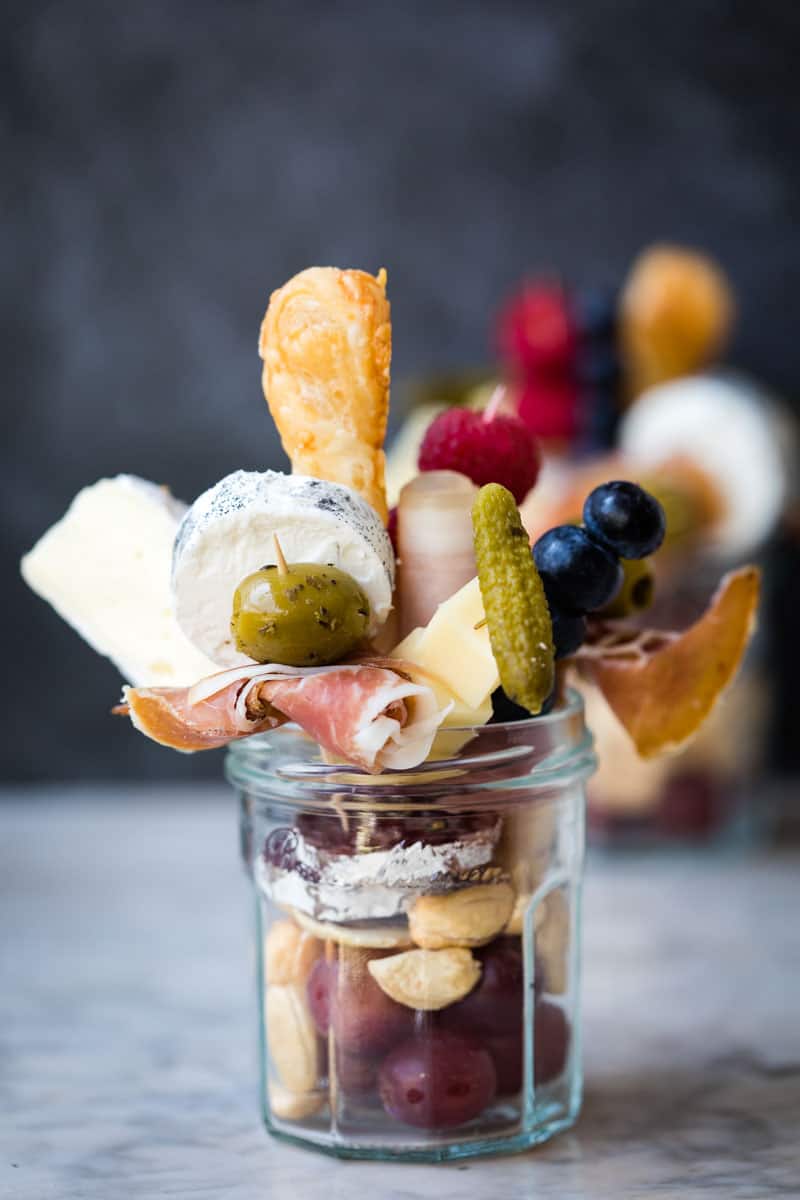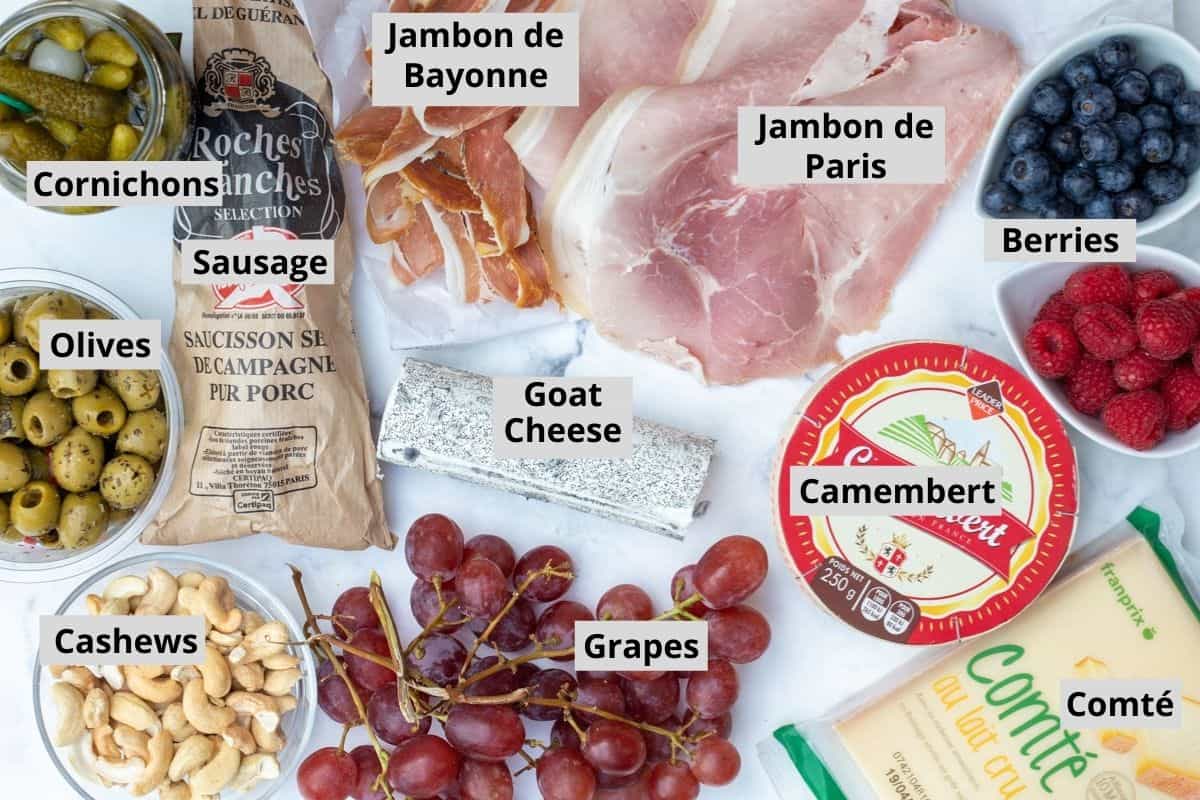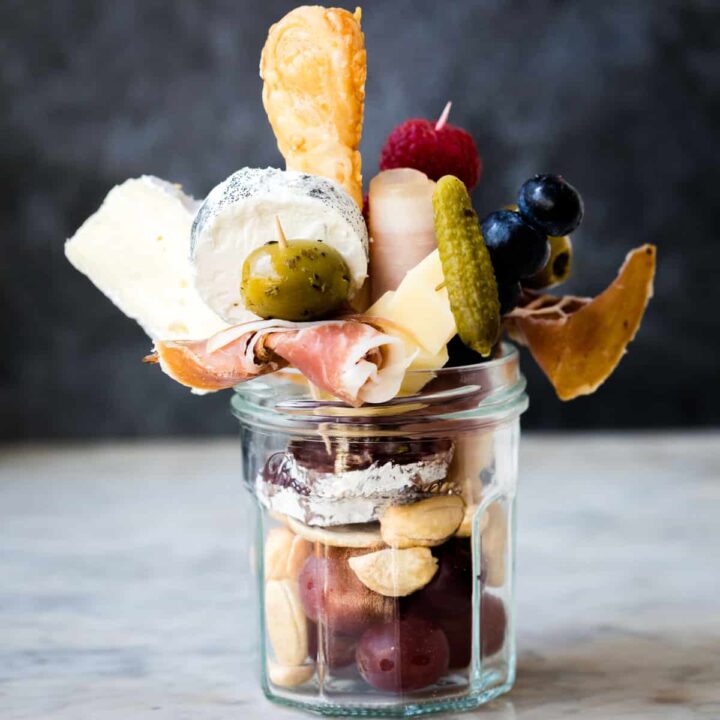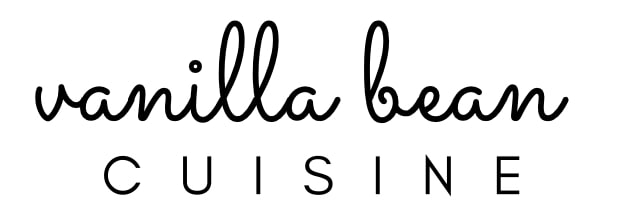This French Jarcuterie recipe shows you how to create a French charcuterie board in adorable jars, along with tips for choosing the French meats and cheeses that will make your friends think they’re sitting in a Parisian cafe!

Charcuterie platters are all the rage now, aren’t they? And with good reason—they’re beautiful, packed with delicious meats and cheeses, and can be accented in so many different ways. In Paris, it’s common to go out for an apéritif (a before-dinner drink) with friends and share a planche with meats or cheeses or both. This recipe breaks down the traditional board into single-serving size—perfect for entertaining.
Jump to:
Why Make This Recipe
- Great Way to Learn About French Meats and Cheeses: Making French jarcuterie gives you the opportunity to learn more about the fantastic meats and cheeses in France, and then share with your friends and family!
- So Easy for Entertaining: Rather than having guests descend on a charcuterie board, they can each grab their own jar and a glass of wine and sit down for some good conversation.
- Good for Portion Control: Don’t trust yourself around a charcuterie platter? (Me neither.) With jarcuterie, you can fill the jar with the amount of meats and cheeses you are comfortable eating (and load up on the berries and grapes if you’re trying to cut down!).

🥩 Meats to Choose for a French Charcuterie Board
Let’s start with the meats. I recommend three of the classic French cured meats:
- Saucisson Sec: This type of dried sausage is made from pork and spices, and is similar to salami. It is dry-cured, which means salt is used to cure the meat rather than the meat being cooked. You can find regional variations with different spices and additions such as garlic or nuts.
- Jambon de Paris: This is one of the most popular types of ham, made by poaching ham in a vegetable broth. It is commonly sliced and used to make two classic French sandwiches, the Croque-Monsieur/Croque-Madame and the Jambon-Beurre (butter and ham sandwich).
- Jambon de Bayonne: This type of aged ham is often compared to Italian prosciutto. Jambon de Bayonne must come from the Bayonne region of France (in the southwest) and is known for its delicate flavor. It is aged at least 7 months.
- Other ideas: You could also include a Boudin Blanc or Noir, which is a sausage that is poached or blanched in a natural casing, rather than dry-cured. These sausages may include fruits or vegetables like onions or apples, or nuts like chestnuts. (Again, look for regional specialties.) Boudin Noir, which includes pig’s blood among its ingredients, gets its name from its very dark red color, verging on black.
🧀 Cheeses to Choose for a French Charcuterie Board
Now for the cheeses. There are so many options to choose from, but I like to have a theme to make it easier to choose. You might decide to choose one French cheese made from each of the main types of milk: sheep, cow, and goat. Or, choose one cheese from each of the 4 main types of French cheeses (soft, hard, goat cheese, and bleu cheese). For this platter, I chose to pick one cheese from the first 3 types.
- Soft Cheese: Camembert or Brie are the classics here, though you could also try Reblochon.
- Hard Cheese: Comté is my favorite hard cheese to offer, as it is extremely popular in France. You can find young Comté, aged for only 4 months, all the way up to Comté aged for 36 months. A good substitute would be a Gruyère, though most of these are actually made in Switzerland. Mimolette would be another option.
- Goat Cheese: There are so many beautiful options here, though many are too soft to put on a skewer or easily arrange into a jar. I’d recommend a firm log that you can slice, like a Sainte-Maure de Toraine. Or something with a firm outside layer, like a Crottin de Chavignol.
- Bleu Cheese: The classic here is the French Roquefort cheese. This would be fantastic on a traditional charcuterie platter, but would be difficult to arrange in a jar without making a mess of it. That said, you could look for a different bleu cheese with a firmer texture if you wanted to add one to your jarcuterie. A Bleu d’Auverne might be slightly easier to slice into chunks.
🥗 Other Ingredients
You'll want to round out your French Jarcuterie with other ingredients that add color, tang, and sweetness to your meats and cheeses.
- Easy Puff Pastry Cheese Straws or other breadsticks
- Nuts (cashews, walnuts, almonds, pistachios)
- Grapes (red or green)
- Olives (black or green)
- Cornichons
- Berries (blueberries, raspberries, blackberries)
- Other fruits (clementine segments, apple slices, pear slices)
Instructions for Assembly
Now it’s time to assemble your jars, and really, that’s completely up to you. Here’s a suggestion, but you can get creative and make the presentation entirely your own! Start with a layer of grapes on the bottom of each jar, then cover with a layer of nuts. Cut sausage into slices or cubes and add to jar. Place 1-2 cheese straws in the jar.
Roll up slices of ham and add to jar, or fold up and use toothpicks to secure them. Slice cheese into cubes, circles, or wedges, and add to the jar using toothpicks. Add the olives and cornichons to the ends of the toothpicks holding meats or cheeses. Thread berries onto their own toothpicks and add to jar. Arrange however you choose!

🧐 Recipe FAQs
Cured meats first came about as a way to preserve meats for a long time. Often, these preparations are made with just the meat, fat, and minimal spices. French farmers are known for their respect for their ingredients and the value they place on traditional farming and processing techniques. In addition, they value the geographic diversity of France, and often use regional spices and techniques in their products. As a result, French charcuterie boards typically include extremely high-quality meats.
Jarcuterie is best assembled not long before you want to serve it, both because the jars are delicate and awkward to store in a refrigerator, and also because the ingredients will start to dry out. If you can move them carefully, you can store them for a couple of hours, but ideally I would not make them much farther in advance than that. (And avoid putting cheese straws or breadsticks in the refrigerator—wait to add those until you are ready to serve.)
French wines, of course! If you know what region of France your meats or cheeses came from, it’s perfect to serve them with a wine from that region as well. Both red or white wines are great pairings for charcuterie. I often choose a medium-bodied red wine that’s a bit fruity—something like a Pinot Noir or a Cabernet Franc. You might also choose a light white wine that’s a little on the sweet side but still has some acid to it, for example a Chenin Blanc. That would be a lovely pairing for the salty ham and rich cheeses.
👩🍳 Expert Tips
For easiest assembly, prepare your ingredients separately before starting to put the jars together. Decide what shapes you will cut the cheeses in, and whether you will roll up your meat slices or fold them onto toothpicks. Assemble the berries on toothpicks and have the rest of your ingredients ready to go. Then figure out what exactly you want in each jar (how many of each item). Now, put them together! I recommend doing one jar first, then replicating it once you have something you are happy with. If you try to fill each jar as you go, you may find at the end that several items don’t fit, and you’ll need to start again.
Looking for ideas for a platter instead of jars? Platters can be great for featuring items that don't fit easily on a stick or into a jar. Sticking with our French charcuterie theme, look for pâtés, terrines, and mousses. Or one of my favorite products: rillettes—this is meat cooked in its own fat (usually then shredded and recombined with the fat before being then placed in a jar). Pork is the most common type of rillettes, but you can also find rabbit, duck, and even salmon rillettes. Any of these would be perfect on a French charcuterie board if you aren’t using jars to serve!

Other Appetizer Recipes
If you love entertaining as much as I do, you may want to check out some of my other appetizer recipes. Here are a few of my favorites:
- Cranberry Brie Bites
- Healthier Baked Spinach Artichoke Dip
- Sweet Pea Ricotta Crostini
- Puff Pastry Pinwheels with Prosciutto
- Cilantro-Lime Crab Salad with Paprika Toasts
- Smoked Salmon Potato Chips with Everything Bagel Seasoning
- Old Bay Shrimp with Dipping Sauce
- Charred Tomatillo and Red Onion Guacamole
If you try this French Jarcuterie recipe, I would love to hear from you! Leave a comment below—I read them all, and your feedback is invaluable to me. And please follow along on Instagram, Pinterest, and Facebook or subscribe to my newsletter. I'd love to inspire you with more delicious, healthy, and seasonal recipes!
Want to Save This Recipe?
Enter your email & I'll send it to your inbox. Plus, get great new recipes from me every week!
By submitting this form, you consent to receive emails from Vanilla Bean Cuisine.
📖 Recipe

French Jarcuterie
This French Jarcuterie recipe shows you how to create a French charcuterie board in adorable single-serving jars.
Ingredients
- 1 small bunch grapes
- 3.5 oz. nuts (cashews, walnuts, pecans, or almonds)
- 3 oz. Saucisson Sec (dried pork sausage)
- 6 cheese straws or other breadsticks
- 3 oz. Jambon de Paris
- 3 oz. Jambon de Bayonne
- 3 oz. Camembert or Brie cheese
- 3 oz. Comté or Gruyère cheese
- 3 oz. firm goat cheese
- 24 olives, pitted
- 12 cornichons
- 30 berries (blueberries, raspberries, or blackberries)
Instructions
- To assemble jarcuterie, start with a layer of grapes on the bottom of each jar.
- Cover with a layer of nuts.
- Cut sausage into slices and add to each jar.
- Place 1-2 cheese straws in each jar.
- Roll up slices of ham and add to jar, or fold up and use toothpicks to secure them.
- Slice cheese into cubes, circles, or wedges, and add to the jar using toothpicks.
- Add the olives and cornichons to the ends of the toothpicks holding meats or cheeses.
- Thread berries onto their own toothpicks and add to jars.
Notes
Make-Ahead: Jarcuterie is best assembled not long before you want to serve it, both because the jars are delicate and awkward to store in a refrigerator, and also because the ingredients will start to dry out. If you can move them carefully, you can store them for a couple of hours, but ideally I would not make them much farther in advance than that. (And avoid putting cheese straws or breadsticks in the refrigerator—wait to add those until you are ready to serve.)
Wine Pairing: Since this is a French-inspired dish, French wines are an excellent pairing! If you know what region of France your meats or cheeses came from, it’s perfect to serve them with a wine from that region as well. Both red or white wines are great pairings for charcuterie. I often choose a medium-bodied red wine that’s a bit fruity—something like a Pinot Noir or a Cabernet Franc. You might also choose a light white wine that’s a little on the sweet side but still has some acid to it, for example a Chenin Blanc. That would be a lovely pairing for the salty ham and rich cheeses.
Nutrition Information:
Yield: 6 Serving Size: 1Amount Per Serving: Calories: 799Total Fat: 41gSaturated Fat: 18gTrans Fat: 0gUnsaturated Fat: 20gCholesterol: 85mgSodium: 853mgCarbohydrates: 86gFiber: 30gSugar: 47gProtein: 33g
Nutrition information is provided as a general reference for users courtesy of the online nutrition calculator Nutritionix.
Instagram Users: Now that you've made jarcuterie, tag me @vanillabeancuisine or #vanillabeancuisine because I'd love to see your results!


Chef Mii says
Hysterical! I’d just have this for lunch thank you very much!
Chef Molly says
An excellent idea. Add a small salad, and it's dinner too!
Jeff the Chef says
Wow, I've never seen anything like this. That would be amazing at a party.
Chef Molly says
Right?! I'm so excited to do this when we can have friends over again!
Heidi | The Frugal Girls says
I am a jar fanatic, so I really am loving your idea to convert a more traditional charcuterie board into single servings using jars. The added benefit of portion control is also genius!
Chef Molly says
Thanks Heidi! I love all things jars too! And fun to use for a food presentation. Now I'm trying to come up with more ideas to fill them!
Katerina says
These jars are such a fabulous idea, Molly, especially for these Covid times! I like how everyone gets their own little selection of meats, cheeses, nuts and fruit - I would love grabbing one of these at a party! Brilliant.
Chef Molly says
Thanks! Honestly, even after life gets back to normal, I may still want my own jar of meats and cheeses! 🙂